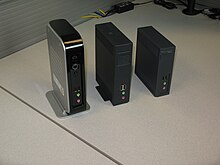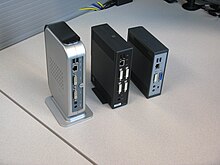

 | |
| Company type | Subsidiary |
|---|---|
| Industry | Computer software, Computer hardware |
| Founded | British Columbia, Canada, 2004 |
| Founder | Dan Cordingley Dave Hobbs Ken Unger Maher Fahmi |
| Headquarters | Burnaby, British Columbia, Canada |
| Products |
|
Number of employees | 200+ |
| Parent | HP Inc. |
| Website | www.teradici.com |
Teradici Corporation was a privately held software company founded in 2004,[1] which was acquired by HP Inc. in October 2021.[2] Teradici initially developed a protocol (PCoIP) for compressing and decompressing images and sound when remotely accessing blade servers, and implemented it in hardware.[3][4] This technology was later expanded to thin clients/zero clients[5] for general Virtual Desktop Infrastructure.[6][7] Teradici's protocol or hardware is used by HP,[8] Dell-Wyse,[9] Amulet Hotkey, Samsung, Amazon Web Services,[10] Fujitsu,[11] and VMware.
On 27 July, 2021, HP Inc announced that it had signed a definitive agreement to acquire Teradici on undisclosed terms, with the deal set to close in calendar Q4, 2021.[12]

Teradici was founded in 2004 by Dan Cordingley, Dave Hobbs, Ken Unger and Maher Fahmi.[13][14] It operated in stealth mode until 2007 when they announced their first products, a blade server card and a small hockey puck shaped client, using a proprietary chip which implemented the PCoIP protocol.[15] In 2008, VMware announced it was licensing Teradici's PCoIP protocol. Teradici developed a software implementation of PCoIP, which VMware started shipping in VMware View 4.[16]
The Teradici name originated from a previous company the founders were incubating. That company's product involved a 100-gigabit data center networking device. One-tenth of a tera is a deci, but "Teradeci" didn't roll off the tongue. "Teradici" was unique, sounded better and the domain name was available at the time.[17]
PC-over-IP (PCoIP) is a proprietary remote display protocol developed by Teradici.[18] The protocol is available in hardware and in software. In 2008, VMware licensed Teradici's PCoIP protocol,[1][19][20] and supports it in VMware Horizon View.[21] In 2013 Amazon licensed the PCoIP protocol for use in AWS Amazon Workspaces.[10][22][23][24][25][26]
PCoIP is a UDP-based protocol that is host rendered, multi-codec and dynamically adaptive.[clarification needed] Images rendered on the server are captured as pixels, compressed and encoded and then sent to the client for decryption and decompression. Depending on the image, different codecs are used to encode the pixels sent since techniques to compress video images differ in effectiveness compared to those for text.[18][27] The protocol also dynamically adapts its encoding based on the available bandwidth. In low-bandwidth environments it uses lossy compression where a highly compressed image is quickly delivered, followed by additional data to refine that image, a process termed "build to perceptually lossless". The default is to use lossless compression which is used when there is minimal network congestion or when explicitly configured, as might be required for scenarios where image fidelity is more important than conserving bandwidth, e.g. for medical imaging.[28][29]

|
| |||||||||||||||
|---|---|---|---|---|---|---|---|---|---|---|---|---|---|---|---|
| |||||||||||||||
| Founders |
| ||||||||||||||
| Directors |
| ||||||||||||||
| Executive officers |
| ||||||||||||||
| Computer hardware products |
| ||||||||||||||
Consumer electronics |
| ||||||||||||||
| Other divisions |
| ||||||||||||||
| Software |
| ||||||||||||||
| Discontinued products |
| ||||||||||||||
| Closed divisions |
| ||||||||||||||
| HP CEOs |
| ||||||||||||||
| Assets |
| ||||||||||||||
| See also |
| ||||||||||||||